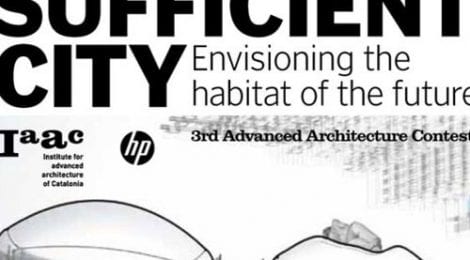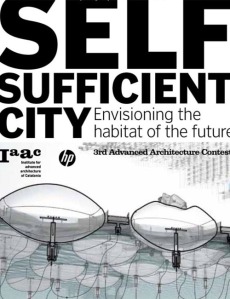
Towards a self-sufficient habitat, by Vicente Gaullart, Head of Urbanism, City of Barcelona
Towards a self-sufficient habitat, by Vicente Gaullart, Head of Urbanism, City of Barcelona
http://elpais.com/diario/2009/03/28/opinion/1238194813_850215.html
This economic crisis is a fantastic starting point to physically change the spaces in which we live, according to new rules of relationship. Should apply the Internet model to habitability
VINCENT GUALLART 28 MAR 2009
The current crisis can be a stimulus to develop a new economy around developing eco-efficient? Spain is a world leader in urban infrastructure development, construction of public facilities and spaces, innovative housing design and good architecture. It is a leader in the production and management of renewable energy. The equivalent electric cars today are developed in the U.S., Germany and Japan which seeks to promote a new global economic stage, may have its replica in the eco-neighborhoods, buildings self-sufficient, and home designs that can be advanced developing in Spain. Is it possible to overcome the debates about the economic crisis of the brick and the opportunity to focus on developing new habitat modeling self-sufficient, which improve our quality of life, and presented to the world?
It should be eco-efficient cities, investing more now to save on future
The figure of the architect who repeated their designs, which franchise is obsolete
The information society and the networked world, has changed the way we inhabit cities, but cities have not changed. They are still designed and built with parameters of industrial society, sometimes disguised doses of sustainability. Current economic circumstances are a great starting point to address the physical transformation of the spaces we live according to new relational rules. How is the distributed model of the Internet to the habitability of the world?
Industrial society was characterized by solving human needs through major infrastructure catering to millions of people. Energy, food and goods were produced centrally with structures created to address the global needs, which then needed logistical mechanisms to bring the individual level such products. These structures work because there were workers who produced and consumed millions of consumers. Now, if consumed, the world does not work. And if consumed, the planet is degraded.
However, worker-consumer of the industrial age they can happen creators-producers connected to the information society capable of producing almost any application locally from a know-how that is shared on a network. This is probably the major paradigm shift that will transform the economy and that should transform the livability of the area.
Faced with a model with few production centers that supplied millions of people with the same product, the Internet fosters the relationship of millions of people who produce diverse content and to customize both the time and the product produced and how is exchanged other network nodes. The application of these structures, the construction of the physical world, promote the development of self-organized structures designed to self-sufficiency, able to create and improve quality of life, and consume fewer resources.
Connected self-sufficiency is the limit of sustainability. This was a concept based on good intentions, not definable from parameters accurate and devoid of content and its indiscriminate use to justify almost any action on the territory. Self-sufficiency raises connected self-organizing themselves to follow the principles of natural systems, which are essential to the sustainability principle in time with the lowest energy consumption. Rather than relying on sustainable development must also undertake a proactive process for the provision of eco-efficient structures built area and production of surplus energy in new developments.
And several of the basic elements of the habitability of the people, directly related to the structures we inhabit can be transformed according to new principles:
1. Energy. Any building, neighborhood or city, should generate 100% of its energy on site through the introduction of sensors integrated into the first buildings, which are shared through smart microgrids. This principle must redefine the very form of architecture that should ensure through its geometry and position in the territory, which is capable of generating energy.
2. Food. Urban is by definition different from agriculture. In the countryside, the food was and the city was consumed. To give value to food, we should encourage the enhancement of large tracts of fertile land located in the vicinity of large cities, direct distribution from the point of the consumer culture and the creation of urban gardens. And these agricultural landscapes should enter their traces and structures in developments at the edges of cities.
3. Manufacturing. The doctrine of recent years, said that in advanced countries are designed and manufactured in emerging. However, the development of advanced manufacturing machinery allows any object can be produced anywhere in the world by anyone, from shared knowledge. Manufacturing laboratories or Fab Labs are the new local factories, which encourage high-value economies and prevent millions of commuting.
4. Internet. After the Internet economy and the social Internet, the next Internet is the Internet of things: objects, places and buildings made with some intelligence, and related to energy conservation, and encourage social interaction. Thus, there is potential to increase the effectiveness of the physical world, providing it with new relational properties, based on criteria developed in an open and transparent.
5. Share. If the physical world is divided between public and private spaces, Internet teaches us the benefits of shared resources. The exchange’s own economy is more than buying and selling. Other models are more focused on the use of things, not on your property, applicable to urban and housing.
6. Knowledge. Knowledge is the key ingredient of the new economy, and research its main production mechanism. Any level of society can be engine of the economy, if research and innovation is encouraged around him. Architecture, and urban development should be able to mix with upcoming disciplines such as urban ecology, landscaping, design of new materials, nanotechnology and artificial intelligence.
These and other changes of paradigms can ferment a structural change in the way they are designed, produced or reformed cities. The architecture must overcome purely iconic stage and return to the essential principles of the systemic, where the project of habitability is understood globally. We need to design neighborhoods and eco-efficient cities, assuming that might have to invest more to save more. The figure of the architect who repeated their designs (which franchise) for cities around the world, is obsolete. And politicians are needed to lead these processes, which manage issues beyond to recognize opportunities in the cities and know the territory and executed, at the right speed.
Now is the time to innovate and create new leadership, rather than selling past accomplishments, or criticizing the excesses of those who wanted to benefit from the system without providing value. Spain has had in recent years a central position in the international urban debate because he knew how to move their social and economic transformation to a physical transformation of their cities and their territory. The development of successful experiences in a new way of building and inhabiting the territory may allow generating new economies move from both developed countries and emerging economies, the experience for the design of new self-sufficient habitats.
Vicente Guallart, architect, is director of Guallart Architects and the Institute for Advanced Architecture of Catalonia.


